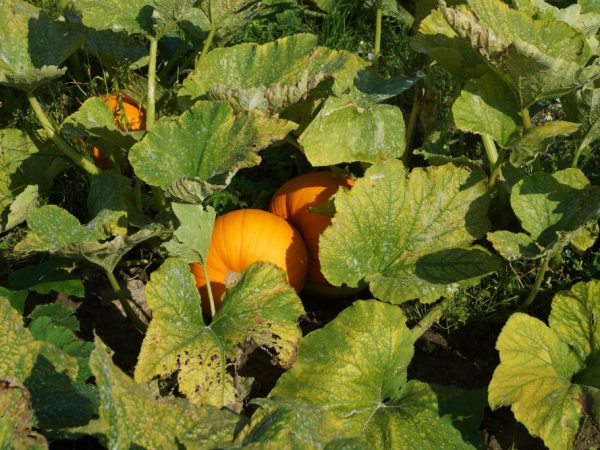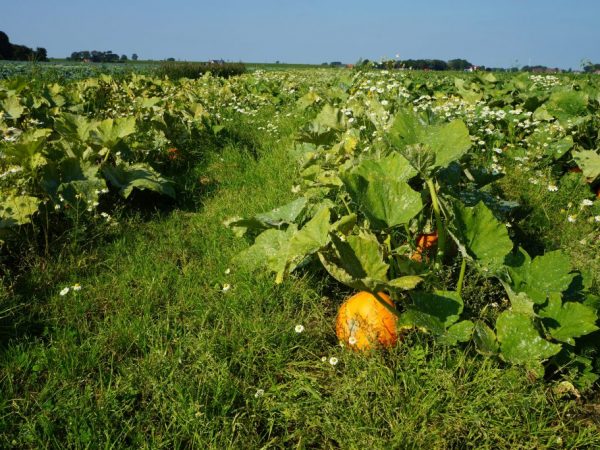When to harvest pumpkin in the suburbs and the Volga region
The pumpkin has an average fruiting period, but it cannot be left standing in the garden - in such conditions it loses moisture, and the pulp dries up.

When to harvest pumpkin in the suburbs and the Volga region
To determine when to harvest the pumpkin, you need to take into account the characteristics of the variety, as well as focus on the ambient temperature. Harvesting times vary depending on the growing region.
Features of choosing a vegetable
On the territory of Russia, only certain types of pumpkin crops are grown - those that can withstand sudden changes in temperature.
For the Moscow region or the Volga region, varieties resistant to various diseases are selected that do not crack even during the period of heavy rains.
These include:
- early ripening;
- mid-season;
- hardy.
Ripening terms
In the south of the country, the pumpkin can be in the open area until autumn, and in cold regions, early planting is organized to harvest by the end of summer.
With the advent of frost, vegetables are completely removed from the garden so as not to lose their taste characteristics. You can use a pumpkin harvester for harvesting.
Pumpkin harvest time depends on the method used by the gardener - automated or manual.
In the Volga region
The Volga region is famous for its temperate climate. In summer, the region is not very hot, so there is no need to choose drought-resistant varieties.
Ripeness comes early, so early maturing species (Almond or Freckle) are suitable. They mature within 3-4 months.
A suitable harvest time for pumpkin is mid or late August. The beds are cleaned before the cold snap. By the fall, the soil is dug up and prepares for wintering.
The pumpkin is stored for up to 2 months, the pulp remains juicy and sweet.
In outskirts of Moscow
On the territory of the Moscow region, it is better to grow hard varieties. They are distinguished by the increased strength of the skin, therefore, they are stored until spring. Fruit ripens later than pumpkin crops grown in colder regions.
The whole September is suitable for cleaning. If it is a rainy summer, then it is better to do it a week earlier.
Harvest with their own hands or with the help of a combine - the hard skin of the pumpkin does not suffer during transportation.
In Siberia
Mid-season varieties are selected. Care for them is minimal, while the vegetable has an average shelf life and good keeping quality.
Growing takes about 4 months.
Harvesting in Siberia takes place in autumn, in September. Previously, the fruits do not have time to ripen, even the earliest crops.
Ripening signs

Ripe pumpkin is not difficult to identify
To find out the ripeness of the product, it is necessary to calculate the planting time and assess the external condition of the vegetable.
Growing under unfavorable weather conditions does not allow you to navigate by date.
The following signs will help you determine when to remove the pumpkin from the garden:
- The first sign of ripeness is a stalk that has changed its color and structure. It is located between the bush and the fruit, and therefore is a nutritious element for the vegetable.If it starts to fade, it means that the fruit no longer feeds on the bush, but "is gaining" sugar. In a ripe vegetable, the stalk is dry and hard.
- Another external sign is yellow leaves. During fruiting, the bush "lets" all the moisture and nutrients to feed the fruit, so the leaves lose most of the moisture. Gradually they dry out, and when the harvest time approaches, they turn yellow. Gradually, the lashes also change color and dry out.
- Skin appearance: it can be bright orange or gray. A rich color indicates that the vegetable is ripe. Green or white color indicates that the vegetable is not yet ripe or has not received proper hydration and nutrition.
- The density of the skin increases. This is done to protect the pulp and seeds.
You can determine the ripeness of a vegetable by cutting one pumpkin. If the inside of the pulp is bright and emits a pleasant aroma, and the seeds are hard and dark, then the fruits can be removed from the garden.
Harvesting
If the beds are dotted with ripe fruits, they must be cleaned in a timely manner. With a sharp cold snap, it is more difficult to separate the stalk from the skin.
Delays in pumpkin harvesting affect the condition of the soil: time is wasted to dig up the site and prepare it for winter.
The dates are delayed if a warm and prolonged autumn is issued. At temperatures below 0 ° C, the crop is harvested urgently. Due to a sharp drop in temperature, the pulp may start to deteriorate. As a result, all stocks will rot.
Harvesting the pumpkin is prohibited in the rain: wet fruits will not dry out and will begin to rot. Choose a warm time.
The fruits are stored until the next sowing. During this period, seeds are taken for planting (from ripe and well-preserved fruits).
Harvest storage
Pumpkin can get sick not only in the beds, but also during storage.
What threatens her:
- fungi multiply in a cool room, the characteristic white bloom quickly spreads over all vegetables;
- if, during harvesting, yellow spots were noticed on the leaves of the bush, the fruits are not used for the preparation of winter storage - they are infected with pathogenic microorganisms.
It is important to preserve the stalk in order to increase the longevity of the pumpkin.
When the first signs of the disease are detected, all fruits are washed with a solution of water and mustard, dried and separated from other supplies.
Conclusion
The ripeness of vegetables depends on their variety, seed quality and growing conditions.
Early-maturing species are collected from the garden in August, and late-maturing - at the end of September. As soon as frosts begin, cleaning takes place urgently.
The fruits are stored in one room, but when the first symptoms of diseases appear, they are distributed in different rooms.

